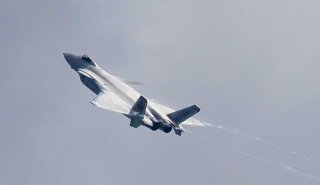China's "Mighty Dragon" Jet Fighter Is Getting An Upgrade
A research fellow for airpower and technology at the United Kingdom-based Royal United Services Institute for Defense and Security called the Mighty Dragon “a qualitatively greater threat than any previous non-Western combat aircraft.”
At the tail end of 2024, two new Chinese stealth fighter demonstrators were revealed. The separate designs put forth by manufacturers Shenyang and Chengdu stunned aviation buffs and military experts alike. Both airframes featured qualities that would make them stealthy, high-performance next-generation platforms. While additional information surrounding these planes has yet to be publicized, their overall design falls in line with what experts have already assumed about China’s future aerial objectives. One of the combat aircraft depicted in leaked videos of the flights is likely a successor to the PLAAF’s current fifth-generation program. The Chengdu J-20 is widely considered to represent one of the most formidable jets of its kind to ever fly the skies. The “Mighty Dragon’s” design, from its fuselage shape and engine intake shape to its paint design and stealth, mirrors the American-made F-22 and F-35 platforms. If a full blown war were to erupt over the South China Sea, the J-20 platform would undoubtedly lead the PRC’s aerial strategy.
A brief overview of the J-20 platform
When the J-20 was first introduced to service, China became the second country ever to release a fifth-generation stealth aircraft. The aircraft was initially endorsed by the PLAAF in the early 2000’s and entered service in 2017. By 2019, considerable numbers of J-20s became operational. Initially, the fifth-generation platform flew with Russian AL-31 engines. The PRC later turned to its domestically produced WS-15 engine, an important transition as the Chinese engine is remarkably more capable than the Russian import as it allows the J-20 to enter a super cruise regime while unlocking the supermaneuverability granted by thrust vectoring.
Specs & capabilities- how does the J-20 compare to its American near-peers?
In terms of capabilities, aviation buffs believe that the J-20 features a sensor suite that parallels the F-35’s Electro-Optical Targeting System. The twinjet all-weather Mighty Dragon has a reported range of 1,200 miles, a servicing ceiling of 55,000 feet and a maximum speed of Mach-2.55. While these characteristics make the Chinese fifth-generation jet a formidable threat to its American near-peers, the extent of the jet’s capabilities remains unknown. A research fellow for airpower and technology at the United Kingdom-based Royal United Services Institute for Defense and Security called the Mighty Dragon “a qualitatively greater threat than any previous non-Western combat aircraft.”
The race to produce sixth-gen platforms is underway
In total, the PRC plans to increase production of the J-20 to match and even exceed the number of American-made Raptors in service today. If the Mighty Dragon reaches this production goal, the potential for incursions over Taiwan will heighten. The PRC remains steadfast in its ambition to seize control of this First Island Chain Nation in the near future. In addition to acquiring more J-20’s, China’s military is prioritizing the production of sixth-generation platforms. The upcoming H-20 Xi’an stealth bomber is Beijing’s counter for the American-designed B-21 Raider. China is also working to develop a next-gen fighter program as made evident by the recent flights of stealth fighter demonstrators.
Maya Carlin is a National Interest security contributor, an analyst with the Center for Security Policy, and a former Anna Sobol Levy Fellow at IDC Herzliya in Israel. She has by-lines in many publications, including The National Interest, Jerusalem Post, and Times of Israel.
Image: Wikimedia Commons.

